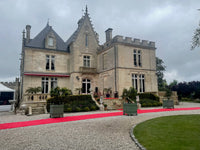
The Bordeaux wine community is notoriously conservative and glacially slow to change. This mindset has been beneficial in producing long-lived iconic wines. But given the monumental transformation the world underwent in 2020, and which continues in 2021, will Bordeaux finally be forced to adapt and modernize its sales and marketing?
Taking a look at the en primeur selling process might provide a clue.

What is Bordeaux "En Primeur"?
Historically, most Bordeaux wine producers, including all major châteaux, sold their wine “en primeur” or as “futures” (in English). “En primeur”, which means “early” in French, is when châteaux present their wines and set prices. It takes place about six months after the harvest while the wine is still in barrel.
Négociants buy the wine on futures directly from the producers and pay for it well before it is bottled. They take possession only after the wine is bottled, usually about 24 months after the harvest at which point they can begin to ship it to importers around the world who in turn sell it to the end consumer.
In the past, large Bordeaux wine producers rarely had direct interaction with the people who drank their wine. But, according to Bordeaux expert Jeffrey Davies of Signature Selections:
“For years now, Bordeaux wine producers have sought such contact notably through the tastings done around the world under the auspices of the Union des Grands Crus de Bordeaux (UGCB) and other organizations. And, slowly but surely, Bordeaux is beginning to follow Napa Valley's lead in wine tourism, encouraging consumers to visit and taste their wines in situ.”
One such example of modernization.
The original idea behind futures was to raise cash for the next vintage. Négociants actually bought wines even before the grapes were harvested, the so-called “sur souche” system, i.e. on the vine! After a few poor vintages, demand fell, forcing producers and buyers into the futures system. A 1973 scandal stopped the system until 1981. Enter Robert Parker with the 1982 vintage and the en primeur system was back in full swing.
In 1924, Château Mouton Rothschild began bottling their wines to guarantee quality throughout the supply chain. Ultimately, châteaux bottled all estate produced wine, while négociants retained sales and distribution.
In 2012, Château Latour took their wines out of the futures market, but continued to work with négociants. Under this arrangement, Latour can sell what they want, when they want. They have more control over the wine and the prices. But economic sustainability remains to be seen in the long term, so Latour remains the only house using this model.
Also in 2012, a Chinese conglomerate attempted to purchase a large négociant house in order to circumvent en primeur. Though minute, négociants face new threats like chateaux hiring their own traders and direct-to-consumer sales.

Times Are A Changin’ for Bordeaux En Primeur
The global pandemic forced massive change on the futures system. Last year, Bordeaux “went digital,” with châteaux sending samples worldwide instead of inviting top professionals and press to the annual en primeur tasting.
After years of price increases, release prices fell significantly for the excellent Bordeaux en primeur futures 2019 vintage. The marketing line was “value,” something usually not associated with high-end Bordeaux.
Sales to airlines, airports, high-end restaurants, and other on-trade venues plummeted in 2020. Recovery of the on-trade business is not on the horizon. Additionally, some large purchasers of futures reduced their commitments in 2020.
But the 2020 campaign succeeded, mostly due to the reduced prices. The industry described such pricing as “market” and unrelated to conditions surrounding the pandemic. But, it may have been a convenient excuse to reset prices in the face of uncertain demand.
Forced to pivot, Bordeaux quickly devised an online tasting process, sending wine to the homes of professionals and journalists.
Those receiving wine enjoyed having more time and attention to savor the wines in an ideal environment, at home where they could taste at their own pace. This is, of course, how most people drink wine. They enjoyed a few Zoom tasting and tracking Liv-ex pricing in real-time.
The major downsides were lack of face-to-face contact and delivered samples that didn’t hold up well compared with barrel tastings.

Looking Ahead at 2021 Bordeaux En Primeur
Looking to 2021 after pivoting to a digital campaign last year, the marketing line is that members learned “from its successes and failures.”
The 2020 harvest experienced extreme conditions that varied considerably around Bordeaux. Though the challenging season ended warm and dry, the impact of climate change was undeniable. The marketing line is “winemaker’s vintage.” One winemaker noted, “Nature is teaching us flexibility.”
Because of these conditions, the en primeur campaign will highlight a greater need for consumer understanding. But, will there be enough interest among consumers and merchants to purchase the wines?
Pivoting in 2021, the Union des Grands Crus de Bordeaux (UGCB) has organized en primeur tastings in 10 cities around the world between April 26 - 29, including Bordeaux, where professionals can taste the 2020 wines from 131 member estates.
As technology evolves from the vineyard to your door, in the future, we could see a modified live experience, a delayed live experience, online/digital tasting events, or some combination.
The new UGCB website, www.vintagebyugcb.com and YouTube channel may provide some clues. Video presentations from the 2019 campaign appear on the site, plus news, interviews, and relevant articles. Classes, conferences, and tastings are also listed.
Last year, producers explained the vintage with online video presentations. Participants used QR codes to access tech sheets. Even with a return to live events, these may continue.
To meet customers where they are, some producers have made plans for online events. After sending samples last year, the process is easier. An online en primeur event is less costly but perhaps less effective due to the lack of personal contact.
A delayed event might offer limited, intimate en primeur tasting sessions in major cities. Delaying en primeur would also allow the industry to maintain tradition but deliver more developed wines, which will likely show much better than typical en primeur samples.
One enterprising packaging company is betting on the digital format by building a new factory in Bordeaux for the “test-tube” style sample packages. However, this type of packaging can lead to premature oxidation. We’ll see how they deal with this in the future.

2021 Bordeaux En Primeur: Out of the Past and Into the Future
For 2021, the unknowns are many. Economies around the world are suffering. Restaurants are slowly dying. Importers and exporters struggle. High tariffs in the U.S. remain though the Biden administration recently announced a 4 month suspension of the last 25% tariff.
Questions remain:
- Will buyers materialize?
- Given the global uncertainty, will consumers want to buy wine they can’t take home for several years?
- Will release prices be low enough to entice buyers?
- How much wine are négociants holding from 2018 and 2019?
- Will payment terms be extended further to attract customers?
While these questions arise every year, the stakes are higher each time.
The Bordeaux wine trade must wake up to these new realities and find creative solutions. There may never be a better time for them to re-position for future growth.
Consumer interest in buying wine futures rose in the 1980s, championed by Robert Parker. Consumers had to rely on experts like Parker for recommendations because they could not taste the wines themselves.
Futures appealed to buyers in good vintages because of lower initial prices for access to exclusive and limited wines including large formats.
Lower prices for the 2019 vintage, initiated by Pontet-Canet at 30% less than prior year, brought both old and new buyers into the market.
Even the Chinese, who had been buying Bordeaux futures up until 2010, shifted to other regions. If demand isn’t strong, it could send a negative signal.
Bordeaux can take the initiative and re-create itself by modernizing en primeur including outreach to consumers. Perhaps they should take a look at other global markets to see what is working elsewhere and how it could be adapted to the unique place that is Bordeaux.
Learn more about futures from our fine wine experts or place an order at bighammerwines.com.
Big Hammer Wines
The wine experts at Big Hammer Wines taste thousands of wines every year from around the globe, looking for quality and value. This special offer reflects the passion we have for our clients.
Discover the world through its wines, Click Here! Visit Bighammerwines.com and become a wine expert!


